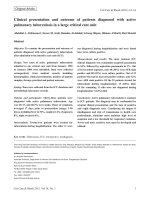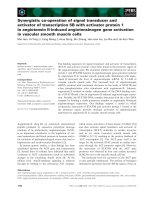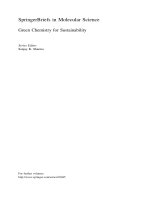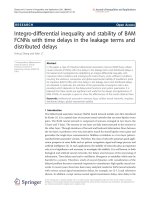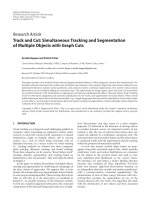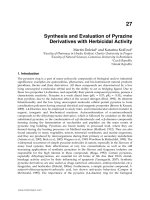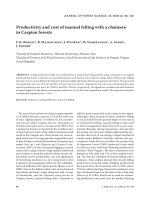metamorphism and end of sed rocks with notes
Bạn đang xem bản rút gọn của tài liệu. Xem và tải ngay bản đầy đủ của tài liệu tại đây (2.36 MB, 37 trang )
Metamorphism and
Metamorphic Rocks
Correctly place the following
statements in the Venn Diagram.
Igneous
Rocks
1. Occurs at divergent boundaries
2. Occurs at convergent boundaries
3. Forms as a result of melting (magma)
4. Temperature is an agent
5. Pressure is an agent
6. Generates foliated rocks
7. Forms as a result of being near an intrusion of magma
8. Found in mountain belts
9. May have been originally been a metamorphic rock
10. Form at temperatures above 200 oC
11. May underlie several adjacent states
al hic
on orp
gi
Re etam
M cks
ro
Daily Question
Contact
Metamorphic
Rocks
Definitions
Metamorphism – mineralogical, chemical,
and physical changes that occur in solid
rocks.
Occurs at depths greater than that of
lithification (Diagenesis).
Solid state recrystallization – changes that
occur without the rock melting (rocks that
melt are igneous).
Factors influencing
Metamorphism
•
•
•
•
Temperature
Pressure
Fluid
Time
Agents of
Metamorphism
Factors influencing
Metamorphism
Temperature
• below about 150oC, most minerals are stable (little or no metamorphism)
• above 150oC, reaction rate increases as temperature increases, new minerals
begin to form
• above 600oC, some minerals begin to melt (transition to igneous rocks)
• Temperature a function of depth within the Earth and the presence of a magma
Factors influencing
Metamorphism
Pressure
• as pressure increases, pore spaces reduced and density increases,
pore fluids are expelled
• Minerals recrystallize and begin to realign
Differential stress
• pressure is greater in one direction than in another
Temperature, Pressure and
Rock Type
Factors influencing Metamorphism
Pore fluids (water and carbon dioxide)
• as pressure increases, pore fluids are
expelled
• Pore fluids increase the rate of metamorphic
reactions by:
• storing ions involved in reactions
• moving ions from one place to another
Chemical Fluids from Magmas
• Carry ions from the melt
• Fluids increase the temperature in the rock
Veins
Solutions are
deposited in
fractures and
joints
Factors influencing
Metamorphism
Time
• solid state recrystallization is a slow process
• in general, size of minerals increases with
time
Types of Metamorphism
1. Burial Metamorphism
2. Contact Metamorphism
3. Regional Metamorphism
Metamorphism & Plate Tectonics
Types of Metamorphism
Burial Metamorphism
• most common type, occurs where crust is greater
than 5 km thick
Relatively low temperature and pressure
(low grade metamorphism)
Maximum stress vertical, foliation parallel to
ground surface
Types of Metamorphism
Contact metamorphism
• Occurs in rocks around a magma body
• High temperature (heat from magma) “bakes”
the rock around the magma creating an
alternation
• High temperature & fluid primary agents, little
to no pressure (occurs at shallow depths in the
crust)
Contact Metamorphism
Contact Metamorphism
Types of Metamorphism
Regional metamorphism
• Large scale – large volume of rock is affected
• Associated with convergent plate margins and
mountain building
• Folding and faulting increase thickness of the
crust
• Occurs over a range of temperatures and
pressures
• Fluids are also present
• Low grade to high grade metamorphism
• Will have zones of contact metamorphism
Regional Metamorphism
Metamorphic Grade
Low Grade Metamorphism
Example: Slate
• Rocks become more dense and compact
• forms at low temperature and pressure
• microscopic crystals
• dull luster
• clay and mica minerals
• foliated
Low Grade - Slate
